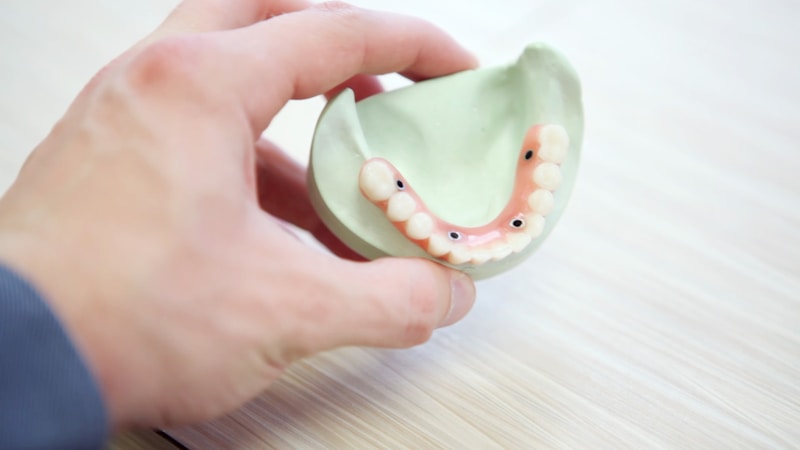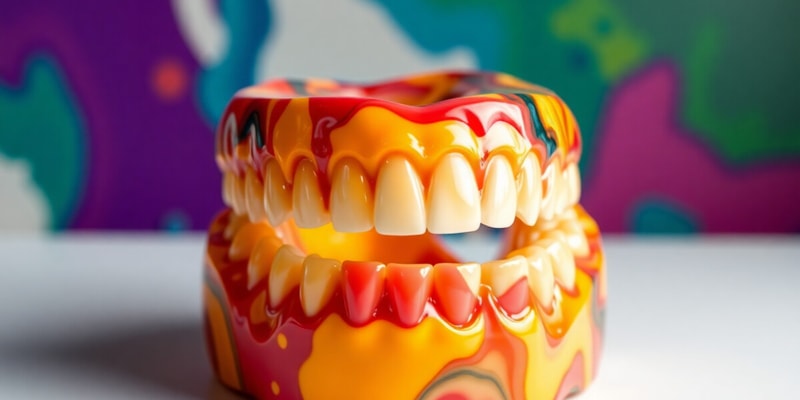Podcast
Questions and Answers
Which process involves small molecules (monomers) joining to form a larger molecule (polymer)?
Which process involves small molecules (monomers) joining to form a larger molecule (polymer)?
Which characteristic is unique to dentine compared to enamel?
Which characteristic is unique to dentine compared to enamel?
What is the most important property for a restorative material used in posterior load-bearing areas?
What is the most important property for a restorative material used in posterior load-bearing areas?
What best describes the smear layer found on dentine surfaces?
What best describes the smear layer found on dentine surfaces?
Signup and view all the answers
Why is a bonding agent applied to etched dentine before placing composite resin?
Why is a bonding agent applied to etched dentine before placing composite resin?
Signup and view all the answers
Study Notes
Material Science of Resin-Based Composites & Compomers
- This presentation covers the material science of resin-based composites and compomers, focusing on their use in dentistry.
Key Concepts
- Clinical question: Indicates a question related to the clinical application of the material.
- Clinical consideration: Highlights important clinical factors to consider regarding the material.
- Materials question: Indicates a question about the material's properties.
Learning Objectives
- Recognize the scientific principles underpinning dental composite resin materials.
- Identify the constituents of dental composite resin materials.
- Outline the processes used in etching and bonding of dental composite resin materials to tooth tissue.
- Outline the limitations of dental composite resin materials.
Outline
- Constituents
- Types of composites
- Compomers
- Etch and bond systems
- Polymerisation
- Limitations
- Clinical applications
MCQs - Question 1
- Which term describes the process of small molecules (monomers) joining to form a large molecule (polymer)?
- Correct Answer: Polymerisation
MCQs - Question 2
- Which characteristic best describes dentine compared to enamel?
- Correct Answer: Contains odontoblastic processes
MCQs - Question 3
- Which property is most critical for a restorative material placed in posterior load-bearing areas?
- Correct Answer: High compressive strength
MCQs - Question 4
- What best describes the smear layer on dentine surfaces?
- Correct Answer: A layer of debris created during tooth preparation
MCQs - Question 5
- What is the main reason for applying a bonding agent to etched dentine before placing composite resin?
- Correct Answer: To seal dentinal tubules and prevent sensitivity
MCQs - Answers
- Polymerization: The chemical process where monomers link to form polymers.
- Dentine: Vital, sensitive tissue with tubules.
- Enamel: Acellular, less sensitive tissue.
- Smear layer: Debris from tooth preparation.
- Bonding agent: Seals dentinal tubules to prevent sensitivity.
- Composite resin: Contains a resin matrix reinforced with inorganic fillers.
Introduction
- Composite materials are mixtures of multiple chemical phases.
- Restore function and aesthetics of damaged or decayed teeth.
- Shift from amalgam fillings to tooth-coloured restorations.
- Demand for materials that mimic natural tooth appearance.
Organic Resin Matrix
- Bis-GMA (Bisphenol A-Glycidyl Methacrylate): High molecular weight reduces shrinkage; provides rigidity.
- UDMA (Urethane Dimethacrylate): Increases flexibility and toughness, enhances handling.
- TEGDMA (Triethylene Glycol Dimethacrylate): Lowers viscosity, improves flow and adaptation, used as a diluent.
Inorganic Filler Particles
- Quartz: Improves wear resistance (hard).
- Silica: Provides translucency and polishability.
- Glass: Barium or strontium glasses add radiopacity.
- Functions: Enhance mechanical properties (strength), reduce shrinkage and expansion, influence esthetics.
Coupling Agents
- Silane coupling agents chemically bond inorganic filler to organic resin matrix; improve mechanical properties, prevent filler dislodgment, and water penetration.
Initiators and Accelerators
- Camphorquinone: Primary photoinitiator activated by visible light.
- Tertiary Amines: Co-initiators to accelerate polymerisation.
- Phenylpropanedione: Alternative initiator for improved color stability.
Additives
- Pigments: Metallic oxides (iron, titanium) adjust shade and translucency.
- Ultraviolet Absorbers: Prevent discoloration from UV exposure.
- Inhibitors: Hydroquinone extends shelf life by preventing premature polymerisation.
Constituents
- Organic resin matrix: Bis-GMA, UDMA, TEGDMA
- Inorganic filler particles: Quartz, silica, glass particles
- Coupling agents: Silane coupling agents
- Initiators and accelerators: Camphorquinone, tertiary amines
- Additives: Pigments, inhibitors, UV absorbers
- Others: Stabilizers, optical modifiers, plasticisers
Macrofilled, Microfilled, Hybrid Composites
- Filler size, Advantages, Disadvantages, Applications
- Characteristics and mechanical properties of each composite type
Flowable and Packable Composites
- Flowable: Lower filler content, increased flow, good adaptation
- Packable: Higher filler content, stiff consistency, mimics amalgam handling; difficult adaptation
Compomers
- Composite resins modified with polyacid groups, incorporate features of composites and glass ionomer cements, resin matrix with acid-functional monomers, fluoride-releasing glass fillers.
Compomers (Cont.)
- Properties: Fluoride release (anti-cariogenic), handling (easy to manipulate), aesthetics (tooth-coloured, acceptable translucency).
- Uses: Pediatric dentistry, Class III and V restorations, orthodontic cementation.
- Limitations: Lower strength compared to composites, potential for water uptake and expansion.
Etching Process
- Purpose: Enhance adhesion, remove smear layer, increase surface energy.
- Etching agents: Phosphoric acid (35-37%).
Procedure (Etching)
- Enamel etching: Apply etchant for 15-30 seconds.
- Dentine etching: Apply for 10-15 seconds.
- Rinsing: Rinse thoroughly for at least 10 seconds.
- Drying: Air dry enamel, keep dentine moist.
- Etching patterns: Type I, II, III
Bonding Process
- Purpose: Establish strong bond, prevent microleakage, distribute stress.
- Bonding systems: Total-etch (etch-and-rinse), self-etch, universal adhesives
Application Steps (Etching, Primer, Adhesive)
- Etching: Procedures
- Primer application: Apply generously, allow thinning to evaporate solvents.
- Adhesive application: Apply uniformly.
Polymerisation
- Free radical polymerisation: Initiation (photoinitiators), Free radicals, Degree of conversion.
- Exothermic reaction: Heat generated during polymerization must be controlled.
Polymerisation Shrinkage
- Mechanism: Monomer conversion to polymers reduces free volume.
- Consequences: Gap formation at tooth-restoration interface, internal stress leading to enamel cracks.
- Strategies to minimize shrinkage: Incremental layering, modified curing techniques, low-shrinkage materials.
Composite Layering Technique
- Why composite increments should not exceed 2 mm: Ensure proper light penetration and complete polymerization.
Limitations
- Polymerization shrinkage
- Wear resistance
- Technique sensitivity
- Discoloration
- Longevity
Clinical Applications
- Anterior restorations: Class III, IV, and V restorations, veneers, diastema closures.
- Posterior restorations: Conservative preparations, elimination of undercuts, use of sectional matrices, attention to occlusal anatomy.
- Minimally invasive dentistry: Prevention, sealants, early lesions, indirect composite restorations (inlays, onlays, veneers).
Materials in SDLE/PDSE
- List of materials and manufacturers used in SDLE/PDSE.
Summary
- Composite resins harden via light-activated polymerization.
- Bonding involves mechanical and chemical adhesion.
- Main composite components are resin matrix, fillers, and coupling agents.
- Etching creates micro-retentions, enhanced by bonding agents.
- Different composites cater to specific clinical requirements.
- Advanced composites improve properties and ease of use.
- Proper techniques lead to successful, durable restorations.
MCQs - Question 6
- Which component in dental composite resins is primarily responsible for reducing polymerization shrinkage?
- Correct Answer: Inorganic filler particles
MCQs - Question 7
- What is the main function of silane coupling agents in composite resins?
- Correct Answer: Bond inorganic fillers to the organic resin matrix.
MCQs - Question 8
- Which factor most significantly contributes to postoperative sensitivity following composite resin restorations?
- Correct Answer:Polymerisation shrinkage causing microleakage.
MCQs - Question 9
- In the context of composite resin restorations, what does the term "degree of conversion" refer to?
- Correct Answer: The percentage of monomer units converted to polymer.
MCQs - Question 10
- What is the main limitation of compomers compared to traditional composite resins?
- Correct Answer: Lower mechanical strength and wear resistance.
MCQs- Answers (Cont.)
- Inorganic filler particles: Reduce shrinkage by occupying space in the resin matrix.
- Bonding agents (silane coupling agents): Create chemical bonds between inorganic fillers and the organic resin matrix.
- Polymerization shrinkage: Creates gaps and microleakage leading to potential sensitivity.
- Degree of conversion: Percentage of monomers converted into the polymer network.
Studying That Suits You
Use AI to generate personalized quizzes and flashcards to suit your learning preferences.
Related Documents
Description
This quiz explores the material science of resin-based composites and compomers with a focus on their applications in dentistry. Participants will assess their understanding of the properties, clinical considerations, and processes involved in using these materials in dental practices.




